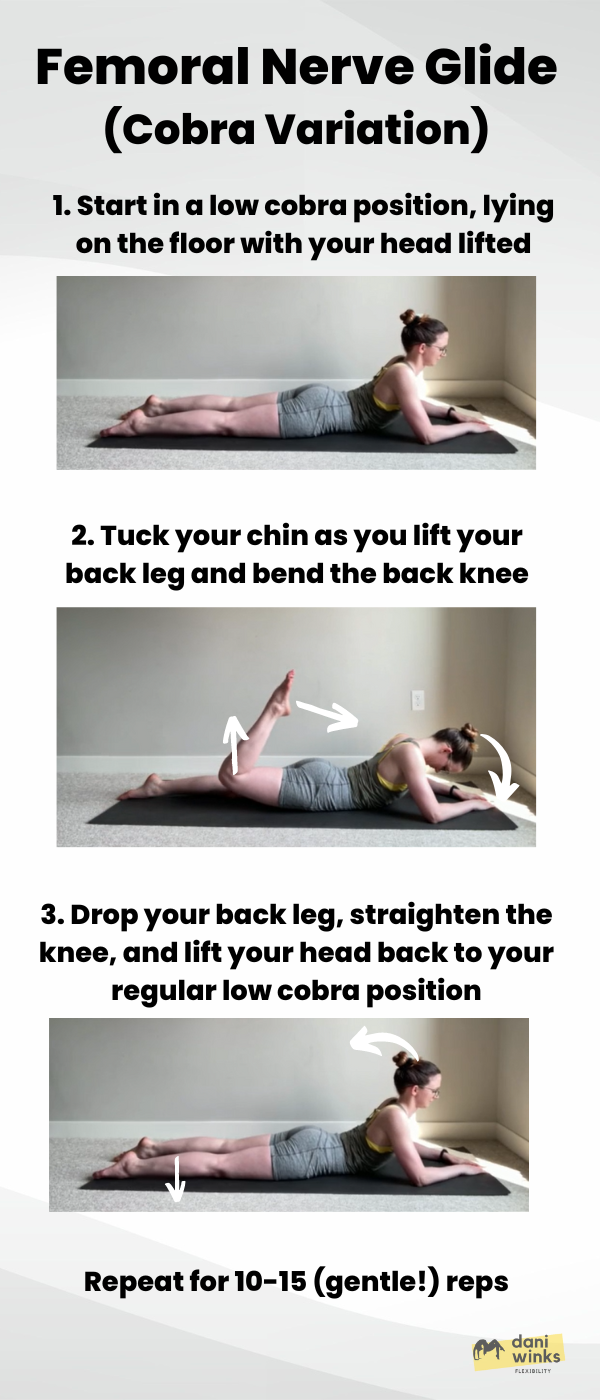How To: Femoral Nerve Glide for Tight Hips (2 Ways!)
How To: Femoral Nerve Glide for Tight Hips (2 Ways!)
As a follow-up to Monday’s post, Stubbornly Tight Hip Flexors? Quick Test for Femoral Nerve Tension, here are two quick, easy nerve glides you can do to help un-stick your femoral nerve before lunging into deeper stretches (pun 100% intended).
Big ol’ disclaimer: this (and all content on this blog, frankly) is meant to be educational - it is not medical advice. Please consult with a medical professional if you have any chronic tightness or nerve discomfort.
Who Can Benefit From Femoral Nerve Glides?
Nerve glides - in the context of flexibility training - are meant for people who have some form of nerve tension to help un-stick their nerves before doing deep stretches where those nerves may be put under more tension. Earlier this week I wrote about how to test if you have femoral nerve tension that could be impacting your hip flexor and/or quad stretches. If that test came back positive, adding a couple of gentle nerve glides to the beginning of your training session can help!
“Best Practices” for Safe Nerve Mobilizations
A couple of important reminders on nerve mobilization “best practices:”
Keep the sensations gentle. Compared to our muscles, nerves are pretty damn sensitive and don’t tolerate being tugged on for long periods of time. Only perform nerve glides in a range of motion that feels easy/comfortable, if you push into any intense sensations (which I know can feel like a satisfying stretch - but dial it back!) that’s usually a sign you’re putting the nerve under too much tension, which can lead to more muscle tightness, or damage your nerve. A good general guideline is you shouldn’t feel anything that’s more than a “level 3” intensity on a 10 point scale
More is not better. Similar to the above, you need to be careful not to overwork the nerves. More nerve mobilizations do not equal happier/glide-ier nerves. Instead, doing too many nerve mobilizations can have the opposite effect. So keep the volume low. No more than 10-20 per nerve, per leg, per day. That’s it! That means you could pick either of the nerve glides listed below (not both).
How To: Femoral Nerve Glides
Femoral Nerve Glide #1: Lunge Variation
This is the variation I use personally because it easily fits into my stretching routine before I do other lunge work on the floor. For folks who get cranky knees in a lunge, you can modify your lunge by adding some knee support, or skip this one and trying the second variation listed in this post.
Start in a 90 degree lunge with your front knee over your front ankle, back knee on the ground, both knees bent 90 degrees. Keep your torso lifted and tailbone lightly tucked so you feel a gentle stretch in the front of your back-leg hip (hip flexors)
Keeping your pelvis in the same position, tuck your chin towards your chest
Lift your head back up as you lean your hips forwards (still keeping your tailbone tucked)
Alternate sliding your hips back while tucking your chin, and pressing your hips forwards while lifting your head. Repeat for 10-15 reps, then switch legs
If you want to make this more challenging for your nerve, you can do this in a rounded back position, letting your upper back round/slouch. Keep your upper back rounded instead of totally flat while you lift/lower your head and slide your hips forwards and backwards. This modification is only a good idea if you can do it without feeling any intense sensations in the front of the hip! (I personally have a decent amount of femoral nerve tension in both hips, so I can’t let my back round in this exercise because it feels intense in my hips. So listen to your body!)
Femoral Nerve Glide #2: Lazy Cobra Variation
This is a gentler-on-the-knees femoral nerve mobilization you can do lying down on your belly.
Start lying on your stomach, propped up on your elbows (like a low cobra or sphynx pose in yoga, but it doesn’t have to be that “proper”)
Lift and bend your back knee, kicking your heel toward your butt, as you tuck your chin toward your chest
Drop your back knee back to the floor and straighten the leg as you lift your chest back to start
Repeat for 10-15 reps, then switch legs



